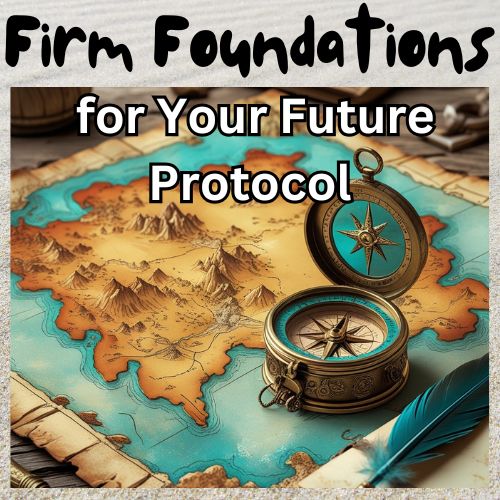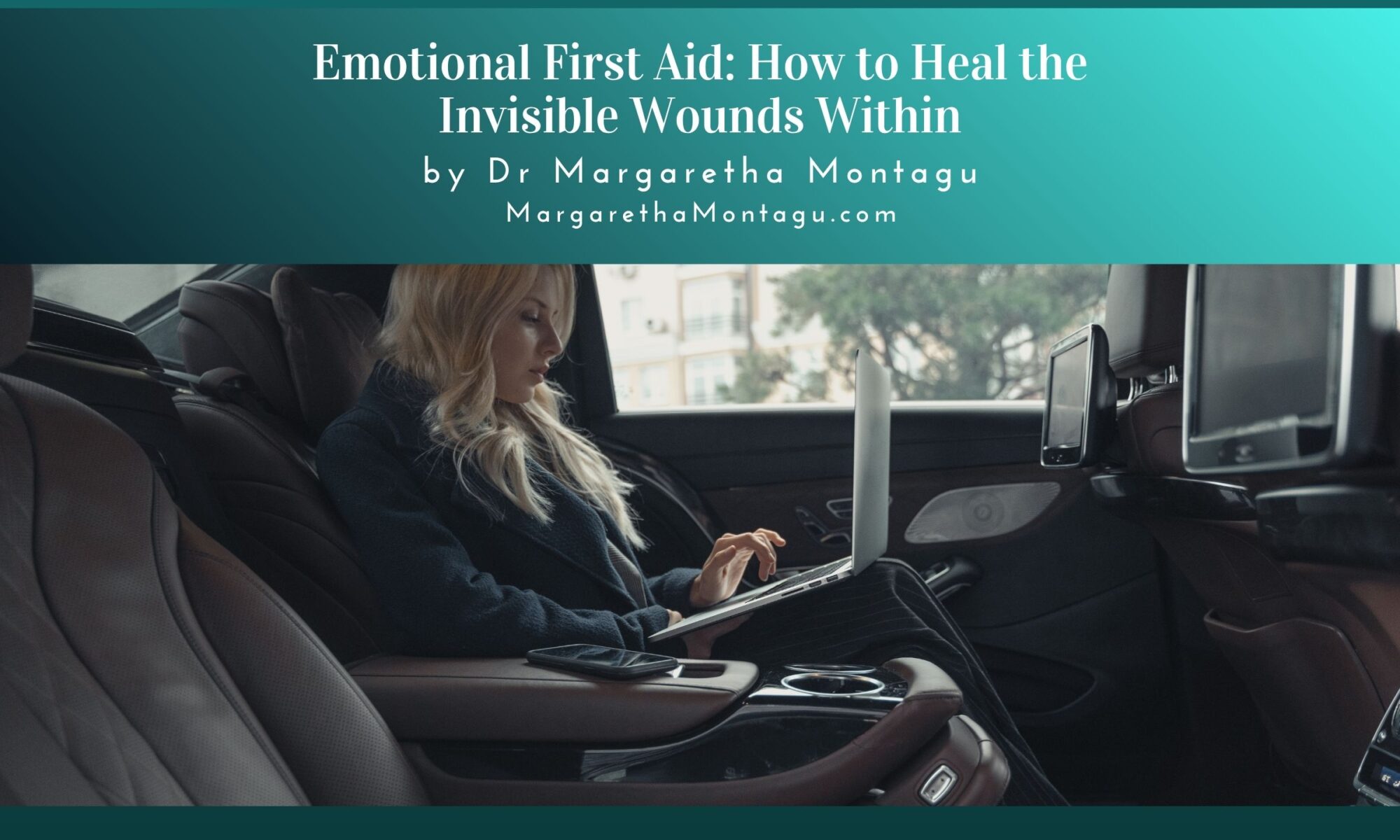What this is: A practical guide to treating emotional injuries with the same urgency and skill you’d apply to a physical wound, because your feelings deserve better than a stiff upper lip and a bottle of wine.
What this isn’t: Another wellness article suggesting you solve your problems with bubble baths and positive affirmations whilst your world crumbles around you.
Read this if: You’re exhausted from pretending you’re fine. You’ve been rejected, betrayed, or humiliated, and you’re still bleeding emotionally whilst everyone expects you to perform flawlessly. You’re a high-achiever who’s brilliant at fixing everyone else’s problems but hopeless at addressing your own invisible wounds.
Time investment: 19 minutes that could save you 12 months of unnecessary suffering.
5 Key Emotional Aid Takeaways
- Emotional injuries are as real as physical ones and require immediate intervention, not stoic denial or self-medication with overwork.
- Rumination is emotional bleeding that drains your energy and delays healing. You can stop it with focused distraction, much like applying pressure to a physical wound.
- Emotional first aid has a protocol just like physical first aid: stop, recognise, validate, stem the bleeding, disinfect (process), and protect (set boundaries).
- Isolation intensifies emotional pain the way infection worsens a physical wound. Connection, whether through trusted friends or support groups, is essential for healing.
- Prevention matters as much as treatment. Setting healthy boundaries and developing emotional resilience prevents future injuries from penetrating as deeply.
Introduction: The Wounds No One Can See
When you accidentally cut yourself whilst preparing your dinner, you know that you need to stop what you are doing, wash your finger and stem the bleeding. Once that’s done, you know you have to disinfect the wound and then cover it with a band-aid, to keep it from getting infected.
We know what we need to do when we get physically injured.
But do we know what to do when we get emotionally injured?
Here’s the uncomfortable truth: most successful professionals would sooner perform surgery on themselves with a butter knife than admit they’re emotionally wounded. You’ve built empires, led teams, made impossible decisions under crushing pressure. You’ve got this. Except when you don’t, and the rejection lands like a punch to the solar plexus, or the betrayal leaves you gasping for air at 3am, or the failure, the humiliation plays on repeat in your mind like a horror film you can’t switch off.
Betrayal, rejection, bullying, abandonment, humiliation, failure, isolation and neglect are all examples of emotional injuries. And just like physical wounds, they require immediate attention, proper treatment, and time to heal.
Yet we treat emotional injuries as character flaws rather than treatable conditions. We expect ourselves to simply “get over it” whilst simultaneously expecting our bodies to take weeks to heal from minor surgery. The cognitive dissonance would be laughable if it weren’t so damaging.
This article offers something radically practical: a protocol for emotional first aid that actually works, drawn from two decades of clinical practice, fifteen years of witnessing transformation on the Camino de Santiago, and the lived experience of both treating and surviving emotional injuries that could have destroyed lesser souls.
Aline’s Story: When Success Wasn’t Enough to Save Her
Aline Patterson sat in her corner office on the forty-second floor, watching the city lights blur through tears she refused to let fall. The leather chair, the mahogany desk, the wall of achievements, none of it mattered anymore. The email glowed on her screen like an accusation: “After careful consideration, we’ve decided to move forward with another candidate for the partnership position.”
Another candidate. Eight years of eighteen-hour days, missed birthdays, sacrificed weekends. Eight years of being the person everyone called when things went catastrophically wrong, the fixer, the closer, the reliable one. And they’d chosen someone else.
The rejection felt physical. Her chest constricted as though someone had wrapped steel bands around her ribcage and was slowly tightening them. The office, usually her sanctuary, suddenly felt like a glass cage, all those windows offering no escape, only reflection after reflection of her own failure.
She’d done everything right. Everything. The taste of her morning coffee turned metallic in her mouth as she remembered the countless times she’d advocated for others, championed their promotions, celebrated their victories. Just last month, she’d recommended Marcus for the senior director role, and he’d got it. She’d written the recommendation that secured Jennifer’s transfer to New York. She’d mentored, supported, advocated.
And when she finally, finally needed something in return? When she’d swallowed her pride and asked the managing partner directly for his support, voice steady despite the vulnerability that felt like standing naked in a blizzard?
“I’ll see what I can do, Aline.”
He’d seen what he could do, all right. He’d done nothing.
The humiliation burned hotter than the rejection. She’d actually believed that competence mattered, that loyalty counted for something, that hard work would be rewarded. How beautifully naive. How utterly foolish.
Her phone buzzed. A text from her sister: “Still on for dinner tomorrow? Can’t wait to celebrate your promotion!” The irony twisted like a knife. Aline’s fingers hovered over the keyboard, but what could she possibly say? That she’d been rejected? That eight years of sacrifice had amounted to precisely nothing? That the future she’d built in her mind had vanished like morning mist?
She pressed her palm against the cool glass window, feeling the city’s pulse forty-two floors below. Down there, people were finishing their ordinary days, heading home to ordinary lives, probably happier than she was with all her supposed success. The scent of her perfume, the same one she’d worn to every important meeting, suddenly made her feel nauseous. Even her own smell felt wrong now, too desperate.
The office was silent except for the hum of the air conditioning and the faint sound of cleaning crews in distant corridors. Everyone else had gone home hours ago. Of course they had. They had lives. Boundaries. She had neither.
Aline opened her desk drawer, looking for paracetamol, anything to dull the pounding in her head. Instead, her fingers found the smooth surface of her leather-bound planner. She pulled it out, flipped to tomorrow’s date. Six meetings, two conference calls, a presentation. The neat handwriting mocked her. So organised. So professional. So utterly pointless.
She wanted to cry, but the tears felt stuck somewhere behind her sternum, hardening into something cold and bitter. Anger? Grief? She couldn’t distinguish anymore. They’d fused into something toxic that filled her chest cavity and made it difficult to breathe properly.
The worst part wasn’t the rejection itself. The worst part was how it had stripped away the story she’d been telling herself for eight years. That she mattered. That she was valued. That she was building something meaningful. Now that story lay in ruins, and she had no idea who she was without it.
Her hand trembled slightly as she reached for her coat. The cashmere felt soft against her fingertips, expensive, a reward she’d bought herself after closing the Masterson deal. Another transaction, another victory, another step towards a partnership that would never materialise.
In the lift descending towards street level, Aline caught her reflection in the polished steel doors. The woman staring back looked hollowed out, as though someone had scooped out her insides and left only the professional shell. Perfectly dressed. Perfectly composed. Perfectly destroyed.
She stepped out into the October evening, the cool air hitting her face like a slap. The city moved around her, indifferent to her pain, to her failure, to the gaping wound in her chest that no one could see but that felt like it might swallow her whole.
Aline Patterson, who barely ever asked for help, who prided herself on her independence, who’d built an entire identity around being the person others relied upon, had finally reached out her hand.
And found nothing there.
Understanding Emotional Injuries: The Wounds We Ignore
If you, for example, who barely ever ask for help, finally are forced by circumstances to reach out and ask for help, only to be refused and rejected, you have been emotionally wounded. You need urgent emotional aid.
The parallel between physical and emotional injuries isn’t mere metaphor, it’s neurological reality. Brain imaging studies reveal that social rejection activates the same neural pathways as physical pain. Your brain literally experiences emotional injury as a threat to survival, triggering cortisol floods and inflammatory responses that can persist for weeks.
Yet whilst we’ve developed sophisticated protocols for physical first aid, we’ve left emotional injuries to fester, treating them as personality weaknesses rather than legitimate medical concerns. This neglect carries consequences that ripple far beyond individual suffering.
In my twenty years as a GP with a particular interest in stress management, I’ve witnessed how untreated emotional injuries compound into chronic conditions: anxiety disorders, depression, substance dependence, cardiovascular disease. The executive who develops hypertension isn’t failing at self-care; they’re experiencing the physiological aftermath of accumulated emotional wounds that never received proper treatment.
Consider the cascade effect. An untreated emotional injury alters your stress response system, making you hypervigilant to future threats. This heightened reactivity affects decision-making, relationships, professional performance. You become the leader who micromanages because betrayal taught you trust is dangerous. The partner who withdraws emotionally because rejection proved vulnerability is foolish. The parent whose own unhealed wounds inadvertently wound their children.
During the years I’ve hosted stress management retreats where professionals walk the Camino de Santiago, I’ve observed a consistent pattern: those who learn emotional first aid don’t merely survive their wounds, they develop a resilience that transforms their entire approach to life’s inevitable difficulties.
The emotional aid protocol is elegantly simple:
Stop what you’re doing. Just as you wouldn’t continue chopping vegetables with a bleeding finger, you cannot process complex emotions whilst maintaining your usual pace. Permission to pause isn’t weakness; it’s wisdom.
Recognise that you’ve been emotionally injured and accept your feelings about the injury without judgment. Whether you’re angry, frustrated, hurt, lost or sad, validating your emotions is the first step towards healing. This isn’t indulgent; it’s diagnostic. You can’t treat a wound you won’t acknowledge exists.
Stem the emotional bleeding, aka rumination, promptly. Dwelling on it, rerunning the incident again and again in your mind, wastes valuable emotional energy that can be used much more effectively to start the emotional healing process. The best way to disrupt unhealthy rumination is to distract yourself by engaging in a task that requires concentration, for example, completing a crossword, even if it’s just for three minutes.
Research from Cambridge University demonstrates that focused distraction for as little as two minutes can interrupt rumination cycles that otherwise persist for hours. This isn’t avoidance; it’s emergency intervention.
Disinfect the wound through processing. Talk to someone you trust. Sharing your feelings with a trustworthy friend or family member can be both therapeutic and cathartic. If appropriate, join a support group. Connecting with others who have experienced similar emotional injuries can validate your feelings and help you cope with the injury. If the emotional injury is severe or persists despite your efforts, seeking help from a therapist can be immensely beneficial.
Over my career, I’ve written eight non-fiction books addressing divorce, loss, unexpected illness, and coping with crises precisely because these universal experiences demand articulation. We need language for our pain, frameworks for our suffering. The thirty-plus testimonials on my website attest not to my brilliance but to the power of proper emotional management.
Protect the healing wound. Focus on activities that nourish your mind, body, and soul. Regular exercise, a balanced diet, and sufficient rest can positively impact your emotional well-being. Writing, especially journalling, or any other creative activity can be a productive way to process emotions and gain new insights. Take care of your emotional health just as you do take care of your physical health.
Prevent future injuries. Set healthy boundaries with people who might be causing or exacerbating emotional injuries. This isn’t cruel; it’s essential. You wouldn’t repeatedly place your hand on a hot stove.
Consider forgiveness when ready. Forgiveness doesn’t mean condoning actions but can free you from carrying the burden of resentment. This is advanced emotional first aid, not an immediate requirement.
Notice emotional injury in others and reach out. A simple text is often enough: “Helping you make it through this dark phase in your life is my priority. I’m here for you, whenever you need me” or “This is a tough time for you. What can I do to help?” Helping others cope with emotional injuries is one of the best ways of learning how to cope better with your own.
The Ripple Effect: How One Person’s Healing Transforms Communities
When Aline finally learned to apply emotional first aid, something remarkable happened. Her healing didn’t just restore her own wellbeing; it catalysed transformation throughout her professional and personal ecosystems.
She recognised that her tendency to overwork stemmed from an unhealed childhood wound of feeling invisible unless she was achieving. Once addressed through proper emotional aid, she began establishing boundaries that initially terrified her. She left work at six. She said no to projects that demanded weekend sacrifices. She stopped checking emails during dinner.
Her team noticed. Initially anxious that her changed behaviour signalled disengagement, they gradually realised they’d been granted permission to do likewise. Productivity actually increased because people arrived rested rather than resentful. Innovation flourished because brains freed from chronic stress could think creatively again.
Aline’s sister, witnessing the transformation, finally addressed her own emotional injuries from a difficult divorce she’d been pretending didn’t affect her. Her healing improved her relationship with her children, who in turn felt safer expressing their own emotional struggles rather than performing constant cheerfulness.
This is how emotional aid transforms communities: one healed person becomes a permission slip for others to acknowledge their own wounds. The executive who admits vulnerability creates a culture where psychological safety becomes possible. The parent who models emotional health raises children who understand feelings aren’t failures.
My stress management retreats on the Camino de Santiago have demonstrated this ripple effect repeatedly. When one participant finally allows themselves to grieve a loss they’ve carried for years, others in the group recognise their own unprocessed grief. The storytelling circles I facilitate with my Friesian horses (Twiss, Kashkin and Zorie) and Falabella horses (Loki and Lito) create spaces where emotional truth becomes not just acceptable but celebrated.
This isn’t therapy; it’s preventative medicine for entire systems.
Further Reading: 5 Unconventional Books on Emotional Aid
- “The Body Keeps the Score” by Bessel van der Kolk
This isn’t a self-help book; it’s a revolution in understanding how trauma lodges in our nervous systems. Van der Kolk’s research demonstrates why emotional injuries can’t be healed through logic alone, essential reading for anyone who’s ever wondered why they “should be over it by now.” - “How to Do Nothing: Resisting the Attention Economy” by Jenny Odell
Odell’s brilliant meditation on attention isn’t obviously about emotional aid, but it addresses the cultural context that prevents us from noticing our emotional injuries: we’re too busy, too distracted, too productive. Healing requires presence, and this book teaches how to reclaim it. - “The Dance of Anger” by Harriet Lerner
Anger is often the immune response to emotional injury, yet we’re taught to suppress it, especially as professionals. Lerner provides a framework for understanding anger as information rather than character flaw, transformative for anyone who’s been told they’re “too sensitive.” - “Man’s Search for Meaning” by Viktor Frankl
Frankl’s account of surviving Auschwitz offers the ultimate perspective on emotional injury and meaning-making. His insights on suffering aren’t platitudes; they’re hard-won wisdom from someone who faced unimaginable wounds and still chose healing. - “Tiny Beautiful Things” by Cheryl Strayed
This collection of advice columns is essentially a masterclass in emotional first aid. Strayed’s responses to others’ wounds demonstrate what it looks like to witness pain without minimising it, offering both empathy and practical wisdom.
P.S. My two-day online course, “Road Map to Resilience: From Burnout to Breakthrough,” provides structured guidance for applying these emotional first aid principles to your specific circumstances. It’s not theoretical; it’s practical intervention for people who need results yesterday.
If you’re feeling overwhelmed, exhausted, or on the edge of burnout, you need immediate support. The Road Map to Resilience: Burnout to Brilliance online course (with the option of adding coaching sessions) is designed for exactly that: a practical, step-by-step course to help you regain control, rebuild your energy, and find clarity in the chaos. This isn’t a quick fix—it’s about proven strategies to calm your nervous system, shift your mindset, and create sustainable resilience. No need to cope with this on your own—let’s get you back on track.

Testimonials: Moving towards Healing
Sarah M., Corporate Lawyer, Camino Retreat Participant:
“I arrived at Dr Montagu’s Camino retreat convinced I didn’t need help, I just needed a break from work. By the second day of walking, I realised I’d been carrying an emotional injury from a professional betrayal for three years, letting it poison every subsequent relationship. The combination of physical movement, Margaretha’s gentle guidance, and the safety of the group allowed me to finally acknowledge the wound. I learned emotional first aid techniques that I now use regularly. Six months later, I’ve rebuilt trust with colleagues and, more importantly, with myself. The retreat didn’t just help me cope; it gave me tools I’ll use for life.”
Julia T., Entrepreneur, Virtual Storytelling Circle Member:
“Joining Margaretha’s virtual storytelling circles felt indulgent initially, as if I should be doing something more productive. But the practice of articulating my experiences, of being truly heard without judgment or advice, has been profoundly healing. I’ve processed emotional injuries I didn’t even recognise I was carrying. The circle has become a monthly reminder that my emotional health matters as much as my business metrics. It’s connection without performance, vulnerability without risk. I leave each session feeling lighter, clearer, more myself.”
FAQs: Emotional First Aid Essentials
Q: How do I know if I need emotional first aid or if I’m just being overly sensitive?
If you wouldn’t question whether a physical injury needs treatment because someone might think you’re “too sensitive,” apply the same standard to emotional wounds. If it hurts, interferes with functioning, or persists beyond a reasonable timeframe, it requires attention. Pain is information, not character assessment.
Q: What if I don’t have time to properly address an emotional injury right now?
This is like saying you don’t have time to stop bleeding. Untreated emotional injuries consume far more time through decreased productivity, impaired decision-making, and relationship damage than immediate intervention would require. The question isn’t whether you have time; it’s whether you can afford not to make time.
Q: Can emotional first aid really work as quickly as physical first aid?
Some aspects work immediately. Stopping rumination through focused distraction provides relief within minutes. Validating emotions reduces their intensity almost instantly. However, deep healing takes time, just as a serious physical wound requires more than a band-aid. The key is beginning treatment promptly rather than expecting instant cure.
Q: What if the person who caused my emotional injury is someone I can’t avoid, like a boss or family member?
Emotional first aid includes boundary setting as prevention. You can treat the injury whilst simultaneously limiting future exposure. This might mean emotional boundaries (not sharing vulnerable information), structural boundaries (limiting contact to necessary interactions), or strategic boundaries (developing exit plans). Healing doesn’t require forgiveness or continued proximity.
Q: How can I help someone who’s clearly emotionally injured but won’t admit it?
You cannot force treatment, but you can create conditions where it becomes possible. Model emotional honesty yourself. Offer specific, non-judgmental observations: “I’ve noticed you seem stressed lately” rather than “What’s wrong with you?” Provide resources without pressure. Simply being consistently available signals that vulnerability is safe. Sometimes witnessing another’s healing becomes the permission slip someone needs.
Conclusion: The Courage to Heal
Here’s what I’ve learned from twenty years of clinical practice, fifteen years of hosting my Camino retreats for wounded souls, and a lifetime of sustaining and treating emotional injuries: healing requires more courage than enduring does.
It’s easier to maintain the fiction of invulnerability than to acknowledge you’re hurt. Easier to numb than to feel. Easier to soldier on than to stop and treat the wound properly. But easy isn’t the same as wise, and stoicism isn’t the same as strength.
True strength lies in recognising emotional injuries as legitimate medical concerns requiring competent treatment. In stopping the bleeding of rumination before it drains your vitality. In seeking connection rather than isolation when wounded. In understanding that healing isn’t linear, perfect, or quick, but it is possible.
The most radical act available to successful, stressed professionals is treating yourselves with the same compassion you’d offer others. Extending to yourselves the same emergency care you’d provide without hesitation to someone bleeding in front of you.
Your emotional injuries are real. They deserve attention. And you deserve healing.
The wounds no one can see still require treatment. The pain no one else validates still deserves acknowledgment. The healing no one else witnesses still transforms lives.
You wouldn’t ignore a bleeding wound. Don’t ignore a bleeding heart.
An Invitation to Walk Towards Wholeness on the Camino de Santiago
Imagine this: you’re walking through the golden hills of south-west France, the ancient pilgrimage route beneath your feet, centuries of seekers who’ve walked this path before you somehow present in every step. The autumn air carries the scent of ripening grapes and sun-warmed stone. Your mind, usually racing with deadlines and decisions, gradually slows to match your footfall’s rhythm.
This isn’t a holiday. It’s a healing.
My Camino de Santiago Crossroads Retreats offers something our hyperconnected, productivity-obsessed culture makes almost impossible: space to acknowledge your emotional injuries without judgment, time to apply proper emotional first aid, and community to witness your healing.









Over three days of mindful walking, you’ll learn practical emotional aid techniques that work in real life, not just in theory. Morning meditation sessions ground you before the day’s walk. Evening storytelling circles, hosted alongside my Friesian and Falabella horses, create safe spaces where emotional truth becomes not just possible but celebrated. These horses, with their profound capacity for presence, somehow perceive the wounds we carry and offer acceptance without agenda.
The retreat combines structured stress management practices with the organic healing that occurs when you disconnect from constant demands and reconnect with your own rhythms. You’ll walk at your own pace, no pressure to perform or achieve. You’ll eat simple, nourishing food prepared with gratitude. You’ll sleep deeply, perhaps for the first time in months.
Most importantly, you’ll discover that acknowledging your emotional injuries doesn’t diminish your strength; it demonstrates wisdom. That seeking support isn’t weakness; it’s courage. That healing is possible, even for wounds you’ve carried so long you’ve forgotten what wholeness feels like.
This retreat isn’t about escaping your life. It’s about returning to it with tools that actually work, resilience that’s genuine rather than forced, and connection to others who understand that success and struggle aren’t mutually exclusive.
The Camino has witnessed healing for over a thousand years. Perhaps it’s time to add your story to that ancient tradition.
This month’s TED talk, Emotional First Aid by Dr Guy Winch, has had 13,360,748 views and more than 400 000 likes.
Journaling can be a powerful tool for coping with emotional injuries and applying emotional first aid. These journaling prompts can help facilitate emotional healing:
Describe the emotion you are feeling right now. Explore its intensity, triggers, and any physical sensations associated with it.
Write a letter to the person or situation that caused the emotional injury. Express your feelings, but this time, allow yourself to release any anger or resentment you’ve been holding onto.
Make a list of your inner strengths, skills and qualities that have helped you cope with emotional injuries in the past. How can you leverage these strengths to heal from the current emotional injury?
Write down positive affirmations that counteract any negative self-talk or limiting beliefs you may have developed as a result of the emotional injury, ex.
- I am worthy of love and acceptance: I recognise that rejection does not define my worth. I am deserving of love and acceptance just as I am.
- Rejection does not diminish my value: I acknowledge that rejection is a part of life, and it does not diminish my value as a person. I am still valuable and deserving of support.
- I release the need for external validation: I no longer seek validation from others to define my self-worth. I love and accept myself unconditionally. I am good enough, regardless of any rejections I may face.
- I let go of past rejections: I release the grip of past rejections on my emotions and thoughts. I am free to embrace new opportunities and experiences. Rejection may shake me, but it will not break me.
- I am not defined by others’ opinions of me: I let go of the need to please everyone or to be universally liked. I am defined by my own values and beliefs.
Journaling regularly can help you gain insight into your emotions. If you find that emotional injuries are significantly impacting your daily life, seeking support from a mental health professional is essential for further guidance and assistance.

Pay attention to yourself and learn how you, personally, deal with common emotional wounds. For instance, do you shrug them off, get really upset but recover quickly, get upset and recover slowly, squelch your feelings, or …? Use this analysis to help yourself understand which emotional first aid treatments work best for you in various situations (just as you would identify which of the many pain relievers on the shelves works best for you). The same goes for building emotional resilience. Try out various techniques and figure out which are easiest for you to implement and which tend to be most effective for you. – Dr Guy Winch

Firm Foundations for Your Future Protocol – a fast-paced, high-impact, future-focused course that facilitates the construction of identity-shaping stories about your future self so that you can make the changes needed to avoid having to go through big life changes again and again—without needing to process your past in depth and in detail.

Author Bio: Dr Margaretha Montagu – described as a “game changer”, “gifted healer”, “guiding light” and “life-enriching author” – is an experienced medical doctor, a certified NLP practitioner, a medical hypnotherapist, an equine-assisted psychotherapist (EAGALAcertified) and a transformational retreat leader who guides her clients through life transitions – virtually, or with the assistance of her Friesian and Falabella horses, at their home in the southwest of France.

